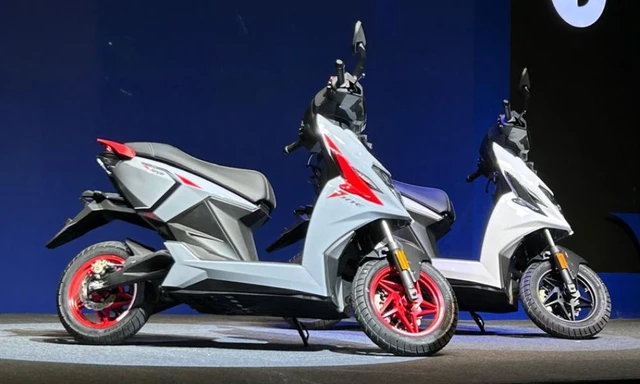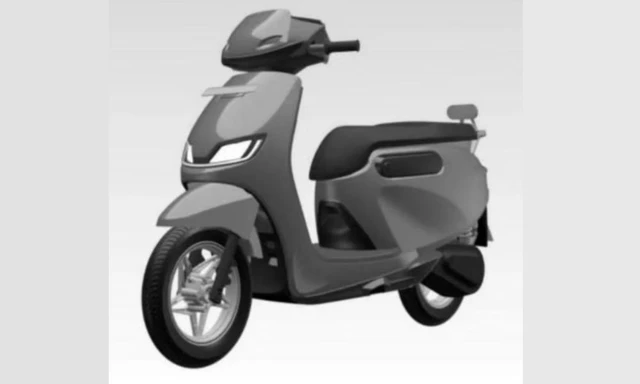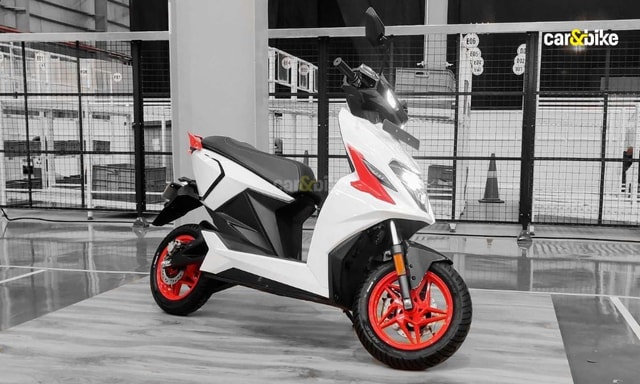Simple Energy One
The Simple Energy One is a electric Scooter bike available at a starting price of Rs. 1.53 Lakh. The electric scooter is available in 1 variants with 6 colour options. The electric motor comes with a lithium-ion battery battery pack. The battery range/mileage of the One is 236 - 265 Km/Full Charge.
Latest Updates on Simple Energy One
Updated Simple One Electric Scooter Launched At Rs 1.50 Lakh; 5 kWh Variant Promises Up To 265 KM Range
Simple Energy Patents New Electric Scooter
Simple Dot One E-Scooter Price To Be Hiked By Rs 40,000 From January 2024
Simple Energy Announces Second E-Scooter – But Where Is The First?
Entry-Level Simple E-Scooter To Come With Fixed Battery; Dot One Name Trademarked
What's New?
Introduction
- The Simple One is an e-scooter positioned as a long‑range, performance‑oriented urban EV.
- It is aimed at riders who seek an affordable and practical solution for everyday commute.
- It competes with other e‑scooters like the Ather 450X, TVS iQube, and Bajaj Chetak.

Simple One – Features and Equipment
- The latest iteration of the One gets an all‑LED lighting setup with LED headlamp, tail‑lamp and turn indicators.
- This new version gets a seven-inch TFT digital console running Android 12, and touchscreen on high-spec variants.
- Other features are dark and light modes, TPMS, 5G e-SIM, LTE, Bluetooth, OTA updates, and onboard storage.
- Connected features in the One include geo-fencing, theft and tow alerts, call and music control via app and more.
- Storage and convenience elements include a 35-litre under-seat storage, 1.0-litre front glovebox, USB ports, carry hooks, and more.
- Then, the One has six riding modes - EcoX, Eco, Ride, Air, Sonic, and SonicX.

Simple One – Powertrain
- The newest iteration of the One is powered by a hub-mounted PMSM electric motor.
- Battery options include 4.5kWh and 5kWh.
- The former 4.5kWh option has a power output of 8.5bhp and 52Nm of torque.
- On the other hand, the latter 5kWh option generates 11.8bhp and 72Nm of torque.
- Furthermore, home AC charging from 0 to 80 per cent takes around 5.5 hours.
- However, if using a fast charger, powering from 0 to 80 per cent will take less than an hour.

Key Highlights:
Ex Showroom Price ₹ 1,69,999 Onwards Class Electric Scooter Mileage Upto 265km Type of engine Permanent Magnet Synchronous Motors (PMSM) Battery Capacity 4.5 kwh to 5 kwh Headlight Type LED Instrument Cluster Digital Seat height 780 mm Weight 126 kg to 129 kg Colours Sonic Red, Brazen Black, Azure Blue,
Grace White, Aero Grey, Brazen X, Asphalt X, Light X, Aero XSimilar Models Ola S1 Pro, Ola S1 Pro Air, Ather 450X, Ather Rizta and TVS iQube
Simple Energy One Price List (Variant Wise)
Simple Energy One Expert Review
- Expert Rating
7.7/10
- Design8.5Safety7.75Comfort7Performance7.5Significance8.75Value for Money8Fuel Consumption7
Simple Energy One
Simple Energy One is a unique proposition as an EV. But how does it measure up to expectations? Here’s a closer look.
It seems to have become accepted practice that newer models of electric vehicles (EVs) that are produced by two-wheeler start-ups are not even close to being ready when they are introduced to the public. August 2021 was the month that Bengaluru-based Simple Energy 'launched' their One electric scooter; however, at the time, the scooter was still very much in the prototype stage. After waiting for what feels like an eternity, we are finally going to be able to ride this much-anticipated electric scooter.
The start-up company based in Bengaluru is in the business of constructing electric two-wheelers from the ground up. The company develops full in-house goods that are made in India, beginning with the design of its surface, continuing with the design of its chassis and moving on to the creation of its batteries, and culminating with the development of its motors. Nevertheless, the trip has not been without its share of difficulties along the way.
In the traditional approach to automotive design, the process begins with the creation of concept sketches, moves on to physical modelling, then moves on to reverse-engineering the physical model, visualization, and finally, physical and digital prototyping. Each phase of the process utilizes a unique piece of software and a unique set of methods, and as a result, the entire process can take a significant amount of time. ALIAS Surface was utilized by Simple Energy to construct three-dimensional models that had a realistic appearance and were derived from product sketches. Alias has enabled them to eliminate the physical and clay modelling process from their workflow, which has resulted in significant time savings. This has given them the confidence to move forward with the development of production-level surface data. The overall size of the file is not particularly large, which means that it is simple to transfer among teams and open in fewer configurations on different platforms. Alias features some of the greatest modules for importing and exporting files, which makes managing files a lot easier for designers. It also allows reverse engineering, which enables our team to quickly transition from mesh data obtained from vendors or suppliers to high-quality Class-A surfaces that are ready for engineering detail design.
Pros
- Sporty design
- Decent performance
- Good range offered
Cons
- Quality Issues
- Limited availability
- Range anxiety
Verdict
The Simple One is quick, sporty and can very easily compete to take on the very best premium electric scooters in the segment. Straight line performance is very impressive, and the dynamics are well-sorted, with sharp handling and agility. As the first electric scooter from a start-up, the Simple ONE indeed is a very promising product. How it is finally introduced in production form, and if it lives up to the claimed range, features and performance, will be key to its success and acceptability. But few things like quality issues and seat design need to be fixed.
One Colour Options
Simple Energy One is available in 6 different colors namely Light X, Brazen X, Grace White, Azure Blue, Namma Red & Brazen Black.
Simple Energy One Image Gallery
Browse through a collection of 44 high-quality images showcasing Simple Energy One
Simple Energy One Mileage
| Mileage | 265.00 Km/Full Charge |
| Mileage Highlights | - |


Quick Compare With Simple Energy One Competitors
 Simple Energy One 1.45 Lakh |  Ather 450X 1.56 - 1.66 Lakh |  Ola Electric S1 Pro Sport 1.5 - 1.65 Lakh |  Okinawa Okhi 90 1.5 Lakh |  Joy e-Bike Mihos 1.58 Lakh |  EeVe Soul 1.48 Lakh |
|---|---|---|---|---|---|
Ex-Showroom Price ₹ 1.45 Lakh | ₹ 1.56 - 1.66 Lakh | ₹ 1.5 - 1.65 Lakh | ₹ 1.5 Lakh | ₹ 1.58 Lakh | ₹ 1.48 Lakh |
C&B Expert Rating 7.7 | - | - | 6.8 | - | 7.1 |
Battery Type lithium-ion battery | Lithium-ion | Lithium-ion (4680 Bharat Cell) | Lithium Ion | BLDC | 60V 20AH Lithium Ion |
Battery Range 236 - 265 Km/Full Charge | 111 Km/FullCharge | ~242 km (IDC) Km/FullCharge | 160 Km/FullCharge | 130 Km/FullCharge | 120 Km/FullCharge |
Charging Time 8 Hrs | 5 Hours 45 Min | ~4 hrs 50 mins | 5 - 6 hours | 5 - 5.5 Hrs | 3-4 Hours |
Fast Charging Time 6 Hrs | 1.5km / min | N/A | N/A | 4 Hrs | N/A |
Kerb Weight 129 Kg | 108 Kg | 116 Kg | 96 Kg | 110 Kg | 140 Kg |
Max Torque 72 Nm bhp | 26.00 | N/A | 250.00 | N/A | |
Variant 1 | 2 | 2 | 1 | 1 | 1 |
Colour Count 6 | 6 | 0 | 3 | 4 | 0 |
Detailed Comparision - |
Calculate EMI For Simple Energy One
User Review Simple Energy One
- 5.0User RatingTap To Rate:
- 5100%40%30%20%10%
- Do You Own This Simple Energy One?Share your experience about Simple Energy One
- Best range and chain drive5.0OneNice design good rangeBy AlexPosted on: Aug 25, 2021 08:34 PM161
- Nice5.04.5 kWh Gen 2(Electric)Nice bike and very good newsBy Kishan DangiPosted on: May 06, 2022 09:37 AM48
Simple Energy One Specs and Features
Explore an in-depth overview of the Simple Energy One specifications and features, offering comprehensive details on its engine, fuel efficiency, mileage, brakes, max power, and tyre. Additionally, gain insights into the bike's advanced safety features.
Specifications
Features
Simple Energy One Latest News & Reviews
 car&bike Team | Jan 5, 2026Updated Simple One Electric Scooter Launched At Rs 1.50 Lakh; 5 kWh Variant Promises Up To 265 KM RangeWith a series of changes made to the existing scooter, the start-up claims to have improved range, top speed as well as on-road behaviour of the Simple One.1 min read
car&bike Team | Jan 5, 2026Updated Simple One Electric Scooter Launched At Rs 1.50 Lakh; 5 kWh Variant Promises Up To 265 KM RangeWith a series of changes made to the existing scooter, the start-up claims to have improved range, top speed as well as on-road behaviour of the Simple One.1 min read Janak Sorap | Oct 27, 2025Simple Energy Patents New Electric ScooterPatent images suggest it to be a family-oriented electric scooter.1 min read
Janak Sorap | Oct 27, 2025Simple Energy Patents New Electric ScooterPatent images suggest it to be a family-oriented electric scooter.1 min read Amaan Ahmed | Dec 27, 2023Simple Dot One E-Scooter Price To Be Hiked By Rs 40,000 From January 2024The Dot One was unveiled on December 15, wearing an introductory price tag of Rs 99,999 – but only for those who already held Simple One bookings.1 min read
Amaan Ahmed | Dec 27, 2023Simple Dot One E-Scooter Price To Be Hiked By Rs 40,000 From January 2024The Dot One was unveiled on December 15, wearing an introductory price tag of Rs 99,999 – but only for those who already held Simple One bookings.1 min read Amaan Ahmed | Nov 28, 2023Simple Energy Announces Second E-Scooter – But Where Is The First?With not even 50 units of the Simple One electric scooter on the roads, a new, cheaper scooter is being pitched to seemingly keep interest alive.1 min read
Amaan Ahmed | Nov 28, 2023Simple Energy Announces Second E-Scooter – But Where Is The First?With not even 50 units of the Simple One electric scooter on the roads, a new, cheaper scooter is being pitched to seemingly keep interest alive.1 min read Amaan Ahmed | Aug 12, 2023Entry-Level Simple E-Scooter To Come With Fixed Battery; Dot One Name TrademarkedThe Simple Dot One electric scooter will slot in below the flagship One model, but will still cost in excess of Rs 1 lakh.3 mins read
Amaan Ahmed | Aug 12, 2023Entry-Level Simple E-Scooter To Come With Fixed Battery; Dot One Name TrademarkedThe Simple Dot One electric scooter will slot in below the flagship One model, but will still cost in excess of Rs 1 lakh.3 mins read
 Janak Sorap | Feb 11, 20252025 Simple One Review: New Features And Some More!We have spent some time with the 2025 Simple One electric scooter that has been updated with new features and a new firmware, and here’s what we have to say about it6 mins read
Janak Sorap | Feb 11, 20252025 Simple One Review: New Features And Some More!We have spent some time with the 2025 Simple One electric scooter that has been updated with new features and a new firmware, and here’s what we have to say about it6 mins read
Explore Popular Simple Energy Bikes
 Simple Energy OneS+1 Variants
Simple Energy OneS+1 Variants- Electric
- 190 Km/Full cha…
- Scooter
* Ex-Showroom₹ 1.4 LEMI starts at₹ 4,617EV
Upcoming Simple Energy Bikes
Simple Energy One Alternatives

 Ola Electric S1 Pro Sport+2 Variants
Ola Electric S1 Pro Sport+2 Variants- Electric
- 242320 Km/Full…
* Ex-Showroom₹ 1.5 - 1.65 LEMI starts at₹ 4,946EV





















.jpg%3Fv%3D1768203272&w=1920&q=90)

.jpg%3Fv%3D1768203272&w=1920&q=90)









































.jpg%3Fv%3D1768203272&w=640&q=90)

.jpg%3Fv%3D1768203272&w=640&q=90)


























